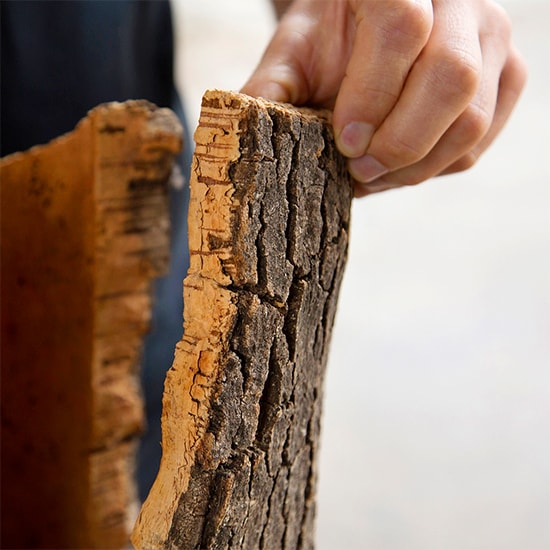Power of cork.
What makes cork such an incredibly carbon-negative material?
Sustainably sourced.
Cork comes from the bark of the cork oak tree. Cork bark is unique in that it has a thick outer layer that can be removed without killing the tree. This means that cork is harvested without ever cutting down a tree or killing it.
It takes between nine and twelve years for the cork tree to regrow its thick bark, at which time it can be harvested again. Since cork trees can live for more than 200 years, each tree can be harvested as many as 15 times.

Cork is harvested by hand in a skilled trade passed down over generations. The bark is carefully cut and peeled away from the trunk of the tree using only an axe. Once harvested, it takes remarkably little energy to process the cork into its finished product.
Bark for wine corks is boiled and allowed to dry before corks are punched out, often by hand. Other cork products are made by the simple and low-energy process of grinding down and re-agglomerating the raw cork.

Remarkable carbon sinks.
The best carbon sinks are big trees with dense wood, like the cork oak which grows to be up to 20 meters (65 feet) tall. When other trees or plants are harvested they can no longer absorb CO2. There is also often a large amount of organic matter left to rot in the area where they grew. As organic matter decomposes it releases CO2 back into the atmosphere.
Unlike other trees, when cork is harvested the tree is left standing to continue absorbing CO2.

Remarkably, harvesting the cork oak tree’s bark boosts the tree’s carbon consumption by three to five times! This is because the tree must absorb more CO2 to turn it into energy to grow back its lost bark.
The result is that for each ton of cork harvested, the cork forest absorbs 70 tons of CO2 from the atmosphere. This means that a single cork represents 70 times its own weight in carbon sequestering.
When companies choose to use cork, they choose to support the world’s cork oak forests and the incredible carbon sequestering potential of those trees.
